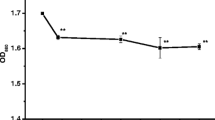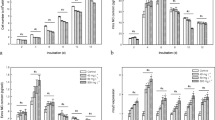Abstract
Changes in growth, photosynthetic pigments, and photosystem II (PS II) photochemical efficiency as well as production of siderophores of Microcystis aeruginosa and Microcystis wesenbergii were determined in this experiment. Results showed growths of M. aeruginosa and M. wesenbergii, measured by means of optical density at 665 nm, were severely inhibited under an iron-limited condition, whereas they thrived under an iron-replete condition. The contents of chlorophyll-a, carotenoid, phycocyanin, and allophycocyanin under an iron-limited condition were lower than those under an iron-replete condition, and they all reached maximal contents on day 4 under the iron-limited condition. PS II photochemical efficiencies (maximal PS II quantum yield), saturating light levels (I k ) and maximal electron transport rates (ETRmax) of M. aeruginosa and M. wesenbergii declined sharply under the iron-limited condition. The PS II photochemical efficiency and ETRmax of M. aeruginosa rose , whereas in the strain of M. wesenbergii, they declined gradually under the iron-replete condition. In addition, I k of M. aeruginosa and M. wesenbergii under the iron-replete condition did not change obviously. Siderophore production of M. aeruginosa was higher than that of M. wesenbergii under the iron-limited condition. It was concluded that M. aeruginosa requires higher iron concentration for physiological and biochemical processes compared with M. wesenbergii, but its tolerance against too high a concentration of iron is weaker than M. wesenbergii.



Similar content being viewed by others
Literature Cited
Campell D, Öquist G (1996) Predicting light acclimation in cyanobacteria from nonphotochemical quenching of photosystem II fluorescence, which reflects state transitions in these organism. Plant Physiol 111:1193–1198
Courtney DG, Ron GT, Carlyn JM, Harold GW (2004) Biological availability of iron to the freshwater cyanobacterium Anabaena flos-aquae. J. Phycol 40:879–886
Davey M, Geider RJ (2001) Impact of iron limitation on the photosynthetic apparatus of the diatom Chaetoceros muelleri (Bacillariophyceae). J Phycol 37:987–1000
Geider RJ, Laroche J (1994) The role of iron in phytoplankton photosynthesis, and the potential for iron-limitation of primary productivity in the sea. Photosynth Res 39:275–301
Imai A, Fukushima T, matsushige K (1999) Effects of iron limitation and aquatic humic subatances on the growth of Microcystis aeruginosa. Can J Fish Aquat Sci 56:1927–1937
Kudo I, Miyampto M, Noiri Y, Maita Y (2000) Combined effects of temperature and iron on the growth and physiology of the marine diatom Phaeodactylum tricornutum (Bacillariophyceae). J Phycol 36:1096–1102
Lammers PJ, Sanders-Loehr J (1982) Active transport of ferric schizokinen in Anabaena sp. J Bacteriol 122:1–11
Lichtenthaler HK, Buschmann C (2001) Chlorophylls and carotenoids-measurement and charaterization by UV-VIS. In Lichtenthaler HK (ed) Current protocols in food analyticial chemistry, supplement 1. Wiley, New York
Machuca A, Milagres AMF (2003) Use of CAS-gar plate modified to the effect of different variables on the siderophore production by Aspergillus. Lett Applic Microbiol 36:177–181
Martin JH, Fitzwater SE (1988) Iron deficiency limits phytoplankton growth in the north-east subarctic Pacific. Nature (London). 331:341–343
Myers J, Kratz WA (1955) Relation between pigment content and photosynthetic characteristics in a blue-green algae. J Gen Physiol 39:11–22
Neilands JB (1995) Siderophores: structure and function of microbial iron transport compounds. J Biol Chem 270:26,723–26,726
Sandstrøm S, Ivanov AG, Park YI, Öquist G, Gustafsson P (2002) Iron stress response in the cyanobacterium Synechococcus sp. PCC7942. Physiol Plant 116:255–263
Schwyn B, Neilands JB (1987) Universal chemical assay for the detection and determination of siderophores. Anal Biochem 160:47–56
Umamaheswari A, Venkateswarlu K (2004) Impact of nitrophenols on the photosynthetic electron transport chain and ATP content in Nostoc muscorum and Chlorella vulgaris. Ecotoxicol Environ Safety 58:256–259
Wells ML, Price NM, Bruland KW (1994) Iron limitation and the cyanobacterium Synechococcus in equatorial Pacificwaters. Liminol Oceanogr 39:1481–1486
Wilhelm SW, Trick CG (1994) Iron-limited growth of cyanobacteria: multiple siderophore production is a common response. Limnol Oceanogr 39:1979–1984
Xing W, Huang WM, Shen YW, Li DH, Li GB, Liu YD (2007) Environmental mechanism of change in cyanobacterial species composition in the northeastern part of lake Dianchi (China). Fresenius Environ Bull 16:82–90
Yu MH, Miller GW (1982) Formation of δ–aminolevulinic acid in etiolated and iron stressed barley. J Plant Nutr 5:1259–1271
Acknowledgments
This work was supported by grants from the National Basic Research Programs of China (2002CB412300, 2003CB716801) and the National Hi-Tech Projects (2005AA601010, 2002AA601013), and the Project of Chinese Academy of Sciences (KSCX2-1-10).
Author information
Authors and Affiliations
Corresponding author
Rights and permissions
About this article
Cite this article
Xing, W., Huang, Wm., Li, Dh. et al. Effects of Iron on Growth, Pigment Content, Photosystem II Efficiency, and Siderophores Production of Microcystis aeruginosa and Microcystis wesenbergii . Curr Microbiol 55, 94–98 (2007). https://doi.org/10.1007/s00284-006-0470-2
Received:
Accepted:
Published:
Issue Date:
DOI: https://doi.org/10.1007/s00284-006-0470-2




